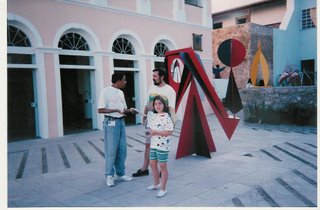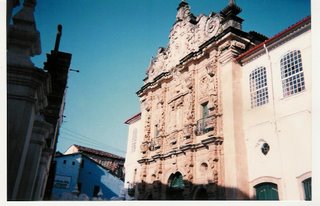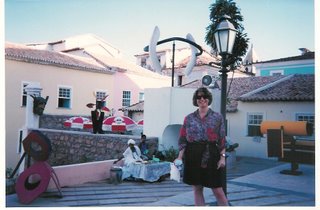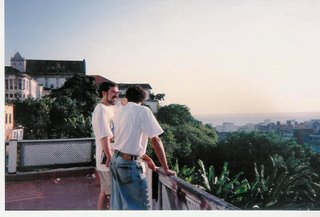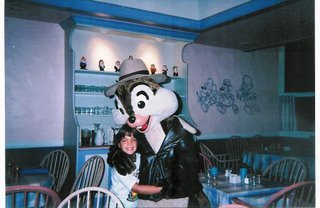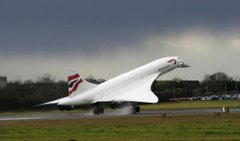BRAZIL - JULY 1993

"BRASÍLIA"
From the tour of the cities mentioned above there are basically no photos at all. The only one taken (the fault is due to the always blamed video recordings) was this one, where the daughter of a friend (a lawyer from the Central Bank of Brazil), who with her brother guided us in Brasilia, appears near one of the ponds of the city.
However, Brasília, the capital city of Brazil, famous for its urban planning, and daring architecture, is worth visiting. Not that you have to spend much time, but the city itself - the concept - deserves a look. The decision to build the new capital city - an article in all republican constitutions demanded the relocation from Rio - was taken by President Juscelino Kubitschek de Oliveira. The main urban planner was Lucio Costa, most of the public buildings were designed by Oscar Niemeyer, and Roberto Burle Marx was the landscape designer. The ideas of Le Corbusier strongly influenced the city plan, which, according to Costa, was supposed to be shaped as a butterfly, though everybody says looks like an airplane.
The main axis (Eixo Monumental) of the airplane has the TV Tower, with spectacular views of the city and the lake, the Kubitschek Memorial, the National Thetre, a futuristic Cathedral designed by Niemeyer, the Esplanade of the Ministries, and the Place of the Three Powers - The Palace of the President, the Congress and the Supreme Federal Court. The wings of the airplane, named North Wing and South Wing, are each roughly 7 km in length, and the avenues between the lake and the wings, have churches, schools and hospitals. All sectors are perfectly designed - the banking sector, the hotel sector, the residential areas, etc. The residential areas are made up of blocks of three or six-storey buildings, named Quadras and Super Quadras. Each block has eleven buildings, with schools, churches and commercial streets placed in between them. Green space and trees complement the location.
Two major criticisms arose, however: one is that Brasília was not designed on a pedestrian scale. Pedestrians had to walk miles to see the monuments and even to cross the roads. The other
is that poor residents were dispplaced to far away satellite towns.
Anyhow, Brasília, which was primarily built in 41 months, from 1956 to April 21, 1960, was also included in UNESCO's World Heritage List.
***
BELO HORIZONTE
Belo Horizonte (meaning Beautiful Horizon in Portuguese), the capital of the state of Minas Gerais, is the fourth largest city in Brazil (after São Paulo, Rio de Janeiro, and Salvador. Belo Horizonte is an interesting city, with several important buildings - the Capela de São Francisco de Assis designed by Niemeyer, the Boa Viagem Cathedral, the Lourdes Basilica, the Museum of Arts and Workmanship, in an old train station, the Nossa Senhora de Fátima church, the old Governor's house (Liberty Palace), and the soccer Stadiun Mineirão, where Cruzeiro, Atlético Mineiro and América Mineiro play their games.
Minas Gerais is also part of the industrial Brazil, and is also known for its cuisine. Should you wish to try the cuisine «mineira» in Belo Horizonte, there is always the chance to eat at the restaurant of Dona Lucinha"
***
CONGONHAS
Congonhas is one of the three historical cities in the state of Minas Gerais, 90km south from Belo Horizonte. The only interesting feature is the remarkable basilica - the Sanctuary of Bom Jesus de Matosinhos - and the sculptures in «pedra sabão» - soapstone - made by Antônio Francisco Lisboa, the Aleijadinho ("Little Cripple)", one of the best artists in the baroque style in the world. The sculptures of the Twelve Prophets at the Sanctuary, as well as the Passion Figures in the six Pavillions at the bottom of the stairs are considered amongst his finest work, his crowning achievement. In 1985 Congonhas was granted the title of Cultural Memorial for Mankind by UNESCO.
***
OURO PRETO
Ouro Preto, the former Vila Rica (Rich Village), was the capital of Minas Gerais from 1822 until 1897, and is one of the most remarkable baroque cities I've seen; locals, known for not being modest, say it is «the largest baroque center in the WORLD".
Founded at the end of the 17th century, Ouro Preto (meaning Black Gold) was the focal point of Brazil's gold rush and keeps several well preserved examples of colonial architecture, including many extremely rich (gold leafed) churches. Some of the Aleijadinho's masterpieces - The Church of Sao Francisco de Assis and the façade of the Church of Nossa Senhora do Carmo - can be found in Ouro Preto. Its museums are also very rich and with beautiful pieces.
Ouro Preto was used in 1994 for the signing of the treaty amending the Treaty of Asunción (1991), which founded the Mercosul (Southern Common Market) - a free trading zone between Brazil, Argentina, Uruguay, and Paraguay. It definitely deserves a visit!
